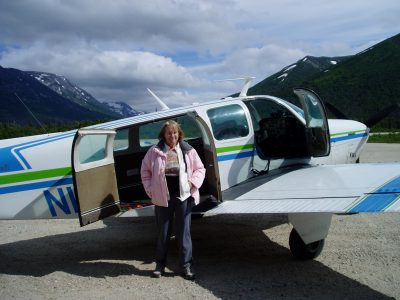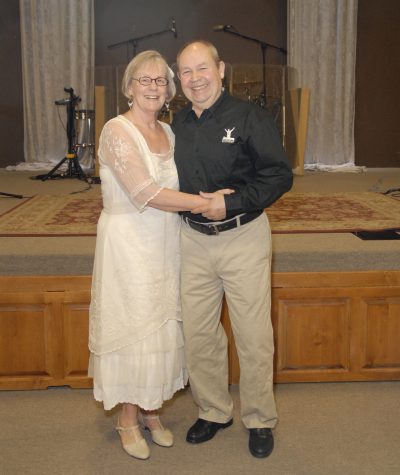Jackie first met with Dr. Qureshi on Halloween. It could have been a frightening day, but she left her appointment with hope for her future.
Jackie has a new goal, she would like to walk from her house into town, which is 4 miles, by the time she is 75. In her late 20s, she had a goal to run a marathon and in her 50s she was hoping to run a half marathon. But she was never able to complete those two goals due to back pain. Now her eyes are set on making it to town, and that is a possibility thanks to her incredible drive and the dedicated team at Golden State Orthopedics & Spine (GSOS).

Her continued ambition for walking faced a few hurdles along the way, which started at a young age.
At age 5 Jackie had polio that left her with weakness throughout her entire trunk and resulted in scoliosis. After wearing a brace for five years Jackie had a thoracic fusion on the middle section of her back to stop the progression of the scoliosis and rotation in her spine. This surgery was done without instrumentation, meaning that no rods were used and the spine was fused together. This was a common practice in the ’60s.
After this surgery, Jackie was able to have a comfortable life. After her schooling, she began working as a nurse and had two children.
But through all of that, her lumbar spine continued to curve and degenerate. When Jackie hit her 50s she started to develop pain in her lower back and right leg. She moved from treating patients at the bedside and started working as a nurse practitioner because it involved less standing and lifting.
After a conservative treatment, Jackie had an anterior lumbar fusion in 2005 for the instability of her spine, and to limit her rotation and dislocation problems. The fusion was incorporated into her original fusion from her childhood.
“I ended up not being able to stand upright after that surgery,” says Jackie. “I was bent over to almost a 90-degree angle pushing a walker.”
Jackie went back to work and continued her physical therapy. With her dedication to physical therapy, she was able to stand upright again but still had problems walking.
A doctor who promised to find a way to fix her back pain
Early in 2007, Jackie started to develop pain, and by October she was unable to even sit up without excruciating pain. She ended up consulting with Dr. Abid Qureshi.
“The day I meet Dr. Qureshi was Halloween 2007, and I went in to see him about the pain I was having,” says Jackie.
Dr. Qureshi and the medical team at GSOS took multiple X-rays in different positions and found that her 2005 surgery left her with a non-union fusion, meaning the segments of the vertebral bone did not merge over the disc space.
“That day he told me that he could fix me. He told me he didn’t know how he was going to do it but said he would find a way. He consulted with six of his colleagues to get their take on how he could rebuild my spine so that I could stand upright and walk.”
Jackie shared her fears after her past surgery, and Dr. Qureshi answered all her questions and set her mind at ease.
After a three-hour appointment, Dr. Qureshi was finalizing his notes, and Jackie realized she would not be able to drive home due to her pain and asked to be admitted to the hospital. She was not looking for pain medication but rather for the drug Toradol that helped reduce inflammation that caused the pain.
After three days in the hospital, Jackie was able to make it back home thanks to the help of some friends. But the pain continued and Jackie was barely able to move. To get a second opinion from a neurosurgeon, her ex-husband drove her in the back of his truck so that she could lie down. The neurosurgeon agreed with Dr. Qureshi’s findings that she needed another surgery.
Time to walk again

Multiple weeks passed, with Jackie finalizing that her insurance would cover the surgery. Finally, in January 2008 Jackie received another lumbar fusion, this time by Dr. Qureshi. The surgery was completed in two eight-hour sessions.
Two days later, Jackie was able to walk again. When Dr. Qureshi came in, Jackie was sitting in a chair, something that was previously too painful. As he approached, Jackie yelled, “I love you, I love you, I love you!”
She recalls, “I was upright and could walk again. I told Dr. Qureshi that I was so grateful he gave my life back. After that surgery, I was up to walking 3 miles a day and healing very well. I had a few setbacks that I caused myself by bending over and not listening to doctor’s orders. But it all worked out.”
Jackie was 58 years old and was so excited to be able to walk again, go back to work and be a contributing member of society again. In 2013 Jackie remarried and was so happy that she was able to walk down the aisle and have a first dance with her husband.
“Without this surgery, I would have never been able to get remarried. I can also go on cruises and long walks. I am living the life,” she says, “and I credit Dr. Qureshi for helping provide that for me.”
Honoring the doctor she learned had helped so many others
During their time together Jackie learned a lot about Dr. Qureshi and his Pakistani culture. She read the book “Three Cups of Tea,” which recounted the custom of sharing a cup of tea with someone. So one day she made tea in a thermos for her appointment with Dr. Qureshi.
“I got into finding little ways to honor him, because he was one of my favorite people,” says Jackie, who continued as she started to cry, “What really stood out to me is how kind he was to me that first day, and he is one of the kindest people I have ever meet.”
Now 10 years later, Jackie is no longer being seen by Dr. Qureshi but is happy to know a doctor like him exists in case she needs his help again in the future.
“I have told many friends about Dr. Qureshi; he is so very thorough, and he is the kindest and smartest man I have ever met.”
Prior to the surgery, Jackie asked Dr. Qureshi how people afford two lumbar fusions, and he mentioned that he loves what he does so much that if he was allowed to, he would do it for free. She knew he was serious because while she was unable to move waiting for surgery she read an article about his past.
“I read about Dr. Qureshi going back to Pakistan in 2005 after a huge earthquake when 73,000 people died and another 135,000 were injured. Most of the women were in their homes trying to protect their children during the earthquake, and a lot of them had broken backs. Dr. Qureshi went back and rebuilt their spines so that they could continue with their lives. So when he told me he would do the surgery for free if he could, I knew he was telling the truth,” says Jackie.
If you are suffering from back pain learn about how Dr. Qureshi can help you.
Contact us today
